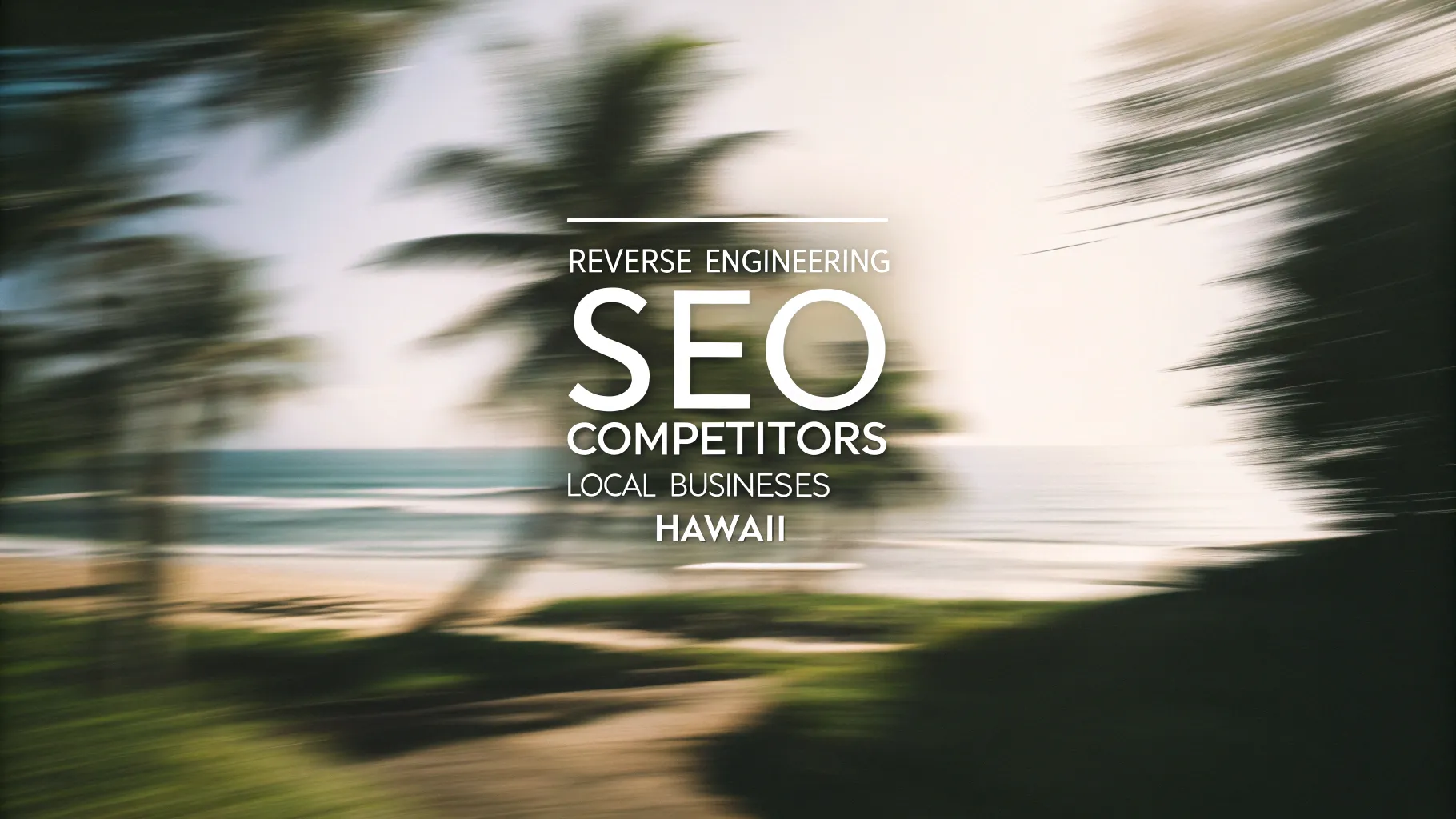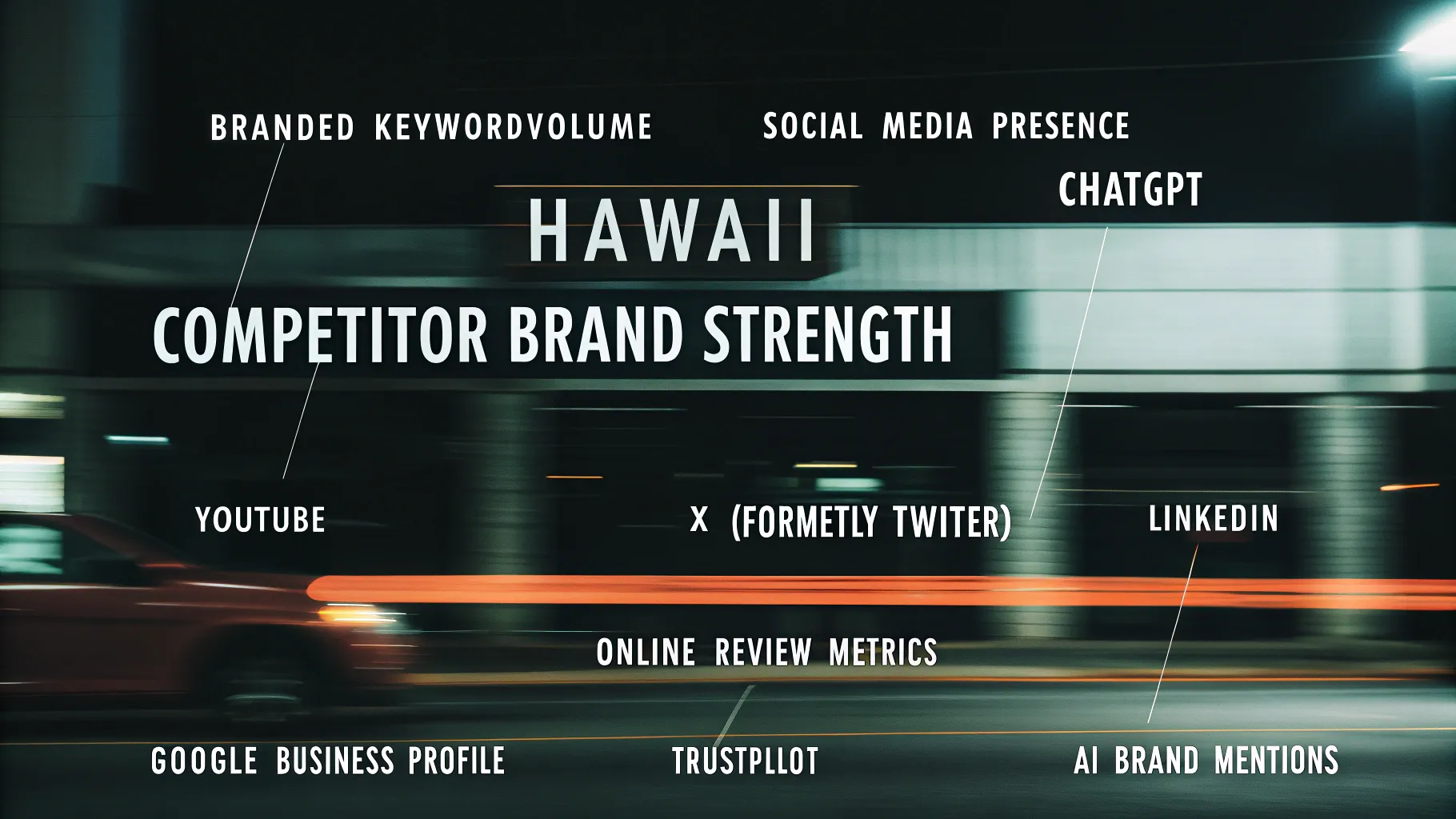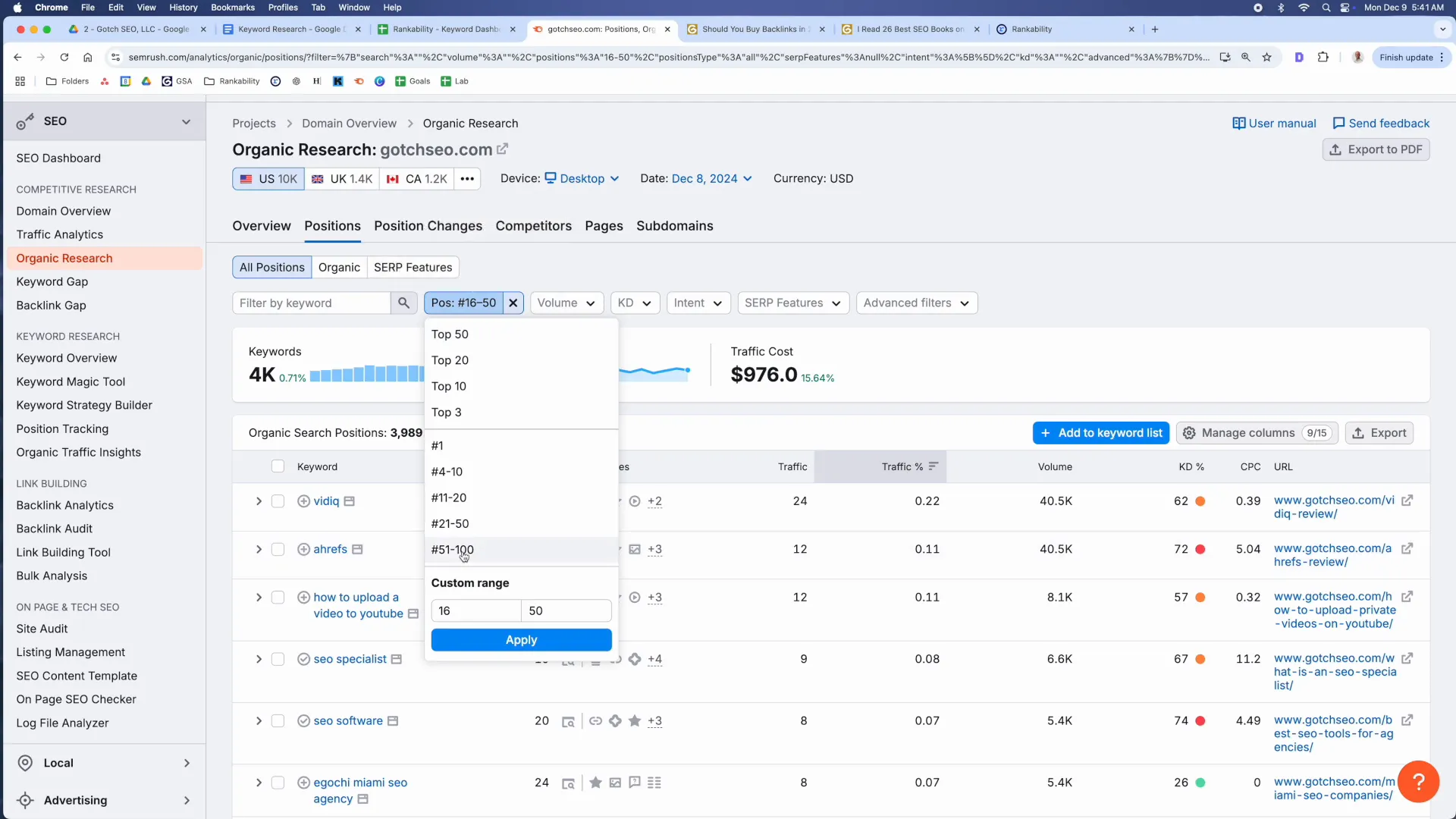In the competitive digital landscape of Hawaii, local businesses face unique challenges in standing out online. Whether you’re a contractor, retailer, or service provider, mastering SEO competitor analysis is crucial to unlocking your business’s full potential. Instead of reinventing the wheel, you can leverage your competitors’ strategies to craft a winning SEO blueprint tailored for the Hawaiian market.
This comprehensive guide, inspired by expert SEO insights from Digital Reach, walks you through a step-by-step process to reverse engineer your SEO competitors like a pro. From gathering traffic data to analyzing content quality and brand presence, these actionable steps will help you close the gap and boost your local SEO performance.
Table of Contents
- 1. Gather Organic Traffic and Backlink Data to Understand the Broad Landscape
- 2. Use Keyword Gap Analysis to Discover Untapped Opportunities
- 3. Crawl Competitor Websites to Extract Structural and Content Insights
- 4. Investigate Competitor Brand Strength to Gauge Market Awareness
- 5. Analyze Competitor Pages at the Keyword Level for Relevance and Quality
- 6. Measure Competitor Topic Authority and Internal Link Strength
- 7. Take Intelligent Action: Optimize Existing Content for Maximum ROI
- Frequently Asked Questions (FAQ)
- Conclusion
1. Gather Organic Traffic and Backlink Data to Understand the Broad Landscape
The first step in your SEO competitor analysis is to gather valuable data on your competitors’ organic traffic and backlink profiles. This foundational insight reveals how much authority and visibility your competitors have and highlights the gaps you need to close.
How to start:
- Use tools like Semrush to conduct a bulk domain analysis. Enter your domain along with at least three of your top local Hawaii competitors to compare key metrics side-by-side.
- Export the report and record the following data in your SEO competitor research spreadsheet:
- Authority Score
- Referring Domains
- Total Backlinks
- Organic Traffic Estimates
- Download the list of referring domains for each competitor to analyze link quality.
Next, use AI tools like ChatGPT to bucket these referring domains by authority score. This categorization helps you understand the strength of backlinks your competitors have, which is critical for setting your link-building budget and strategy.
For Hawaii local businesses, this is especially important because industries such as tourism, real estate, and home services can have varying levels of backlink competition. For example, a local contractor might find fewer high-authority backlinks in their niche compared to a statewide tourism business, affecting how aggressively they need to pursue link building.
2. Use Keyword Gap Analysis to Discover Untapped Opportunities
Understanding which keywords your competitors rank for—but you don’t—is a goldmine for local SEO strategy. This “keyword gap” shows you where you can focus your content creation efforts to capture new traffic.
Action steps:
- Within Semrush, use the Keyword Gap tool. Enter your domain and your top three competitors.
- Filter the results to view “untapped” keywords—those your competitors rank for in the top 100 but you do not.
- Export this list and add it to your research template. Prioritize commercial and local intent keywords relevant to your Hawaii business.
For instance, if you run a painting business in Honolulu, you might discover competitors ranking for “exterior painting services in Oahu” or “eco-friendly painters Maui” that you haven’t targeted yet. Filling these gaps with high-quality content tailored to local searchers can quickly improve your rankings.
3. Crawl Competitor Websites to Extract Structural and Content Insights
Website crawling tools like Screaming Frog provide detailed data on your competitors’ site architecture, indexed pages, content volume, and internal linking. This step reveals how competitors organize content and signals relevance to search engines.
How to execute:
- Run a crawl on your top competitors’ websites, focusing on indexable pages.
- Export the HTML data and analyze key metrics such as:
- Number of Indexed Pages
- Total Word Count on Indexable Pages
- Unique Internal Links (a proxy for site structure and user navigation)
- Pages with Backlinks (how many pages have external link authority)
- Calculate the ratio of pages with backlinks to total indexed pages. A higher ratio indicates strong link distribution across the site, a powerful trust signal for Google.
For local Hawaii businesses, this analysis is particularly useful. For example, a local landscaping company might find that a competitor has hundreds of indexed pages covering specialized services like “Hawaii drought-resistant landscaping” or “Maui garden maintenance,” supported by backlinks. Matching or exceeding this content depth and internal linking will be critical to compete effectively.
4. Investigate Competitor Brand Strength to Gauge Market Awareness
SEO success isn’t just about content and links—it’s also about brand awareness. Strong brands enjoy higher click-through rates, more branded searches, and better trust signals.
To measure your competitors’ brand strength, focus on these key areas:
- Branded Keyword Volume: Use Semrush’s Keyword Overview tool to estimate search volume for competitors’ brand names. This indicates how often people search specifically for them.
- Social Media Presence: Collect follower counts from major platforms like YouTube, X (Twitter), and LinkedIn. A large, engaged audience translates to more branded searches and inbound traffic.
- Online Reviews: Check third-party review sites relevant to your industry—Google Business Profile for local businesses, G2 or Capterra for SaaS, Trustpilot for e-commerce. Track review quantity and average ratings.
- AI Brand Mentions: Emerging SEO tactics include measuring brand mentions on AI platforms like ChatGPT and Google Gemini using tools like Otterly. This reflects brand visibility in conversational search and AI-driven queries.
For Hawaii businesses, local brand awareness is crucial. For example, a Maui-based general contractor with strong local reviews and a growing YouTube channel showcasing project walkthroughs will naturally dominate branded searches. If your brand awareness is lower, investing in local content marketing, social media, and reputation management is essential.
5. Analyze Competitor Pages at the Keyword Level for Relevance and Quality
Once you understand the broad SEO landscape, it’s time to drill down to individual pages targeting important keywords. This micro-level analysis helps you see why competitors rank well and how your pages compare.
Steps to follow:
- Use a content optimization tool like Rankability to measure the relevance and thoroughness of competitor pages for a specific commercial keyword.
- Compare their Rankability score with your page’s score to identify content gaps.
- Check on-page SEO basics using browser extensions such as Majestic or Chrome SEO extensions:
- Keyword presence in URL
- Title tag
- Meta description
- H1 tag
- First sentence
- Use tools like Originality.ai to evaluate if competitor content is human-written or AI-generated. This insight helps you align your content strategy.
- Perform qualitative analysis of competitor pages by evaluating:
- Copywriting quality
- Design and user experience
- Readability and social proof
For example, a local Hawaii roofing company might find that competitors have well-optimized pages with detailed service descriptions, customer testimonials, and professional design. Matching this quality while integrating local keywords like “Honolulu storm damage repair” is vital to compete.
6. Measure Competitor Topic Authority and Internal Link Strength
SEO success depends heavily on topic authority—the breadth and depth of content around a core subject—and internal linking that distributes page authority effectively.
How to measure:
- Use site search queries (e.g.,
site:competitorwebsite.com "keyword") to count how many pages relate to your target keyword or topic. - Assign a score based on the number of supporting assets:
- 1 page or less = 1
- 2-5 pages = 2
- 6-10 pages = 3
- 11-20 pages = 4
- 21+ pages = 5
- Check internal links to the ranking page using Screaming Frog crawl data. More unique internal links typically correlate with better rankings.
- Review the number of referring domains pointing to the ranking page to assess backlink strength on a page level.
For a local Hawaii business, this means creating a robust content hub around your core services and ensuring your site architecture supports easy navigation and link flow. For instance, a Maui landscaping business might benefit from multiple blog posts covering “Hawaii native plants,” “drought-tolerant landscaping,” and “garden maintenance,” all interlinked to boost topic authority.
7. Take Intelligent Action: Optimize Existing Content for Maximum ROI
After collecting and analyzing all this data, the next step is to take action that delivers the biggest return with the least effort.
One of the most effective strategies is:
- Upgrade and optimize existing SEO content. Instead of starting from scratch, enhance your current pages by filling content gaps, improving on-page SEO, adding internal links, and building backlinks.
- Focus on aligning your content’s quality and relevance with top competitors identified in your analysis.
- Regularly update your content to maintain topical authority and freshness.
For Hawaii local businesses, this approach is especially practical given the often limited marketing budgets. By optimizing existing pages that already have some traffic, you can amplify results faster and more cost-effectively.
To learn more about optimizing your content effectively, check out these actionable SEO techniques by Digital Reach.
Frequently Asked Questions (FAQ)
Q1: How can local Hawaii businesses find their top SEO competitors?
Start by searching for your primary service keywords on Google and note the top-ranking local businesses. Tools like Semrush also allow you to identify competitors based on shared keywords and traffic overlap. Additionally, look at local directories and review sites where your business appears.
Q2: What’s the best way to analyze backlinks for local competitors?
Use backlink analysis tools such as Semrush or Ahrefs to export referring domains. Then categorize these links by authority to understand the quality and quantity. For local businesses, focus on backlinks from local directories, chambers of commerce, and community organizations.
Q3: How important is branded search volume for local SEO?
Branded search volume reflects how well-known your business is among your audience. For local businesses in Hawaii, increasing brand awareness through local events, sponsorships, and social media can boost branded searches, which positively impact SEO.
Q4: Should I focus on AI-generated content or human-written content?
It depends on your competitors’ content strategy. If they predominantly use human-written content with high engagement, it’s wise to do the same. However, if AI-generated content is common and effective in your niche, you can consider leveraging AI tools for efficiency while maintaining quality.
Q5: How can I improve my site’s internal linking structure?
Audit your website to ensure all important pages receive internal links from relevant content. Use descriptive anchor text and link from high-authority pages to newer or lower-ranked pages. This helps distribute link equity and improves user navigation.
Conclusion
Reverse engineering your SEO competitors is a strategic approach that offers a clear pathway to improving your local business’s online visibility in Hawaii. By systematically gathering data on traffic, backlinks, content, and brand presence, you gain actionable insights that help you close the gaps and outperform your competition.
Remember, the key is to take intelligent action based on data—whether that means optimizing existing content, building a stronger backlink profile, or enhancing your brand awareness through local marketing efforts. For tailored support in navigating the unique challenges of Hawaii’s market, consider partnering with a trusted agency like Digital Reach, specializing in local SEO and digital marketing strategies designed to boost your business’s growth.
Ready to take your SEO to the next level? Start by implementing these seven essential steps and watch your Hawaii business thrive online.







